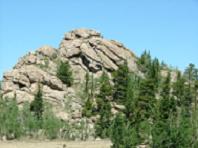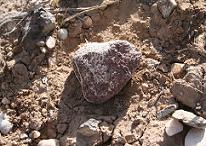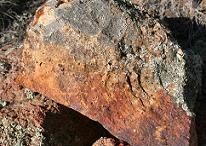The Park features a 3,405 surface-acre reservoir lying on the South Platte River at the southern edge of South Park. Formed behind Elevenmile Canyon Dam, other drainages emptying into the reservoir include Cross, Prudence, Union, Balm-of-Gilead, Simms and Spring creeks.
 The South Platte River Valley is mantled with Wisconsin-aged glacial outwash material (Pleistocene alluvium) which covers older formations. The southeastern portion of the park has been covered by Como-age surface deposits. Most of the park is underlain by Precambrian rocks: Silver Plume granite east and south of Howbert Point and Pikes Peak granite along the river west of Howbert.
The South Platte River Valley is mantled with Wisconsin-aged glacial outwash material (Pleistocene alluvium) which covers older formations. The southeastern portion of the park has been covered by Como-age surface deposits. Most of the park is underlain by Precambrian rocks: Silver Plume granite east and south of Howbert Point and Pikes Peak granite along the river west of Howbert.
 The western and southern edges consist of Thirtynine Mile andesite deposits; igneous and metamorphic rocks of Tertiary origin. Cross Creek also cuts through another Tertiary deposit called Trachyte (also an igneous and metamorphic rock).
The western and southern edges consist of Thirtynine Mile andesite deposits; igneous and metamorphic rocks of Tertiary origin. Cross Creek also cuts through another Tertiary deposit called Trachyte (also an igneous and metamorphic rock).
Along the southwestern reservoir margin, Wall Mountain Tuff, part of a south-dipping sequence of welded Tuffs that incorporated volcanic ash and pumice, is exposed as steep cliffs. Thirtynine Mile andesite has been deposited over both the granite and Tuff formations on the southern reservoir edge.
 Pleistocene alluvium is alluvium that was formed during the Pleistocene Epoch. The Pleistocene Epoch occurred between 1.8 million to 10,000 years before the present and covers the time of the world’s recent period of repeated glaciation. This is also the period during which the rise of early humans occurred. Wisconsin-age refers to the final period of glaciation within the current ice age, as well as to being geographically located within central North America. This age began about 110,000 years ago and ended between 15,000 to 10,000 years before the present.
Pleistocene alluvium is alluvium that was formed during the Pleistocene Epoch. The Pleistocene Epoch occurred between 1.8 million to 10,000 years before the present and covers the time of the world’s recent period of repeated glaciation. This is also the period during which the rise of early humans occurred. Wisconsin-age refers to the final period of glaciation within the current ice age, as well as to being geographically located within central North America. This age began about 110,000 years ago and ended between 15,000 to 10,000 years before the present.
Alluvium is simply soil or sediments deposited by a river or other running water and it is typically made up of a variety of materials, including fine particles of silt and clay, and larger particles of sand and gravel. Flowing water associated with glaciers may also deposit alluvium, but deposits directly from ice are not alluvium.
Precambrian rock is rock that was formed during the Precambrian Era. The Precambrian Era spanned a period of time from the formation of the Earth (around 4.5 billion years ago) to the evolutionary point of abundant macroscopic hard-shelled animals, which marked the start of the Cambrian Era, some 542 million years ago.
 Granite is a common and widely occurring type of intrusive, felsic, igneous rock. Igneous rock is formed by the solidification of cooled magma and it is intrusive if the crystallization or solidification occurred underground. Felsic is a term referring to silicate minerals, magma and rocks that have been enriched with lighter elements like silicon, oxygen, aluminum, sodium and potassium. Granite has a medium to coarse texture and can be pink to dark gray or even black. Outcrops of granite tend to form tors and rounded massifs. Granite is nearly always massive, hard and tough.
Granite is a common and widely occurring type of intrusive, felsic, igneous rock. Igneous rock is formed by the solidification of cooled magma and it is intrusive if the crystallization or solidification occurred underground. Felsic is a term referring to silicate minerals, magma and rocks that have been enriched with lighter elements like silicon, oxygen, aluminum, sodium and potassium. Granite has a medium to coarse texture and can be pink to dark gray or even black. Outcrops of granite tend to form tors and rounded massifs. Granite is nearly always massive, hard and tough.
Pikes Peak granite is a widespread geologic formation found in the front range of Colorado, including around the Pikes Peak region. Silver Plume granite is slightly pinkish in color and occurs in the central portion of the Front Range, much of it around Rocky Mountain National Park. They were both created by cooled magma but were the result of different geologic events.
 Andesite is an igneous, volcanic rock, of intermediate composition, with fine to large grained crystal texture. The mineral assemblage of andesite is typically dominated by plagioclase (tectosilicate minerals found within the feldspar family) plus pyroxene and/or hornblende. Alkali feldspar may be present in minor amounts. Andesites are characteristic of subduction zones, where two tectonic plates meet and move towards one another, with one moving beneath the other. Thirtynine Mile Andesite simply refers to the type of andesite formed around the extinct Thirtynine Mile volcano area. The Tertiary period of geologic time covers roughly the time span between the demise of non-avian dinosaurs and the beginning of the most recent ice-age, approx. 65 to 1.8 million years ago.
Andesite is an igneous, volcanic rock, of intermediate composition, with fine to large grained crystal texture. The mineral assemblage of andesite is typically dominated by plagioclase (tectosilicate minerals found within the feldspar family) plus pyroxene and/or hornblende. Alkali feldspar may be present in minor amounts. Andesites are characteristic of subduction zones, where two tectonic plates meet and move towards one another, with one moving beneath the other. Thirtynine Mile Andesite simply refers to the type of andesite formed around the extinct Thirtynine Mile volcano area. The Tertiary period of geologic time covers roughly the time span between the demise of non-avian dinosaurs and the beginning of the most recent ice-age, approx. 65 to 1.8 million years ago.
Andesite is formed extrusively, from hot magma that has flowed out onto the Earth's surface as lava or has exploded violently into the atmosphere to fall back as pyroclasts (fragments of pre-existing rock composed primarily of volcanic material) or Tuff (volcanic ash ejected from vents). The main effect of extrusion is that the magma cools much more quickly in the open air or seawater and there is little time for the growth of crystals. Often a residual portion fails to crystallize at all, instead becoming an interstitial natural glass or obsidian.
 Trachyte is another igneous, volcanic rock. The mineral assemblage consists of essential alkali or sanidine feldspar and is usually somewhat porous in appearance, and very often has minute irregular steam cavities which make the broken surfaces of specimens of these rocks rough and irregular. It is from this characteristic that trachyte derives its name. Feldspar is the name of a group of rock forming minerals and sanidine refers to the type of feldspar that contains potassium that has been placed under high temperatures, such as volcanic activity.
Trachyte is another igneous, volcanic rock. The mineral assemblage consists of essential alkali or sanidine feldspar and is usually somewhat porous in appearance, and very often has minute irregular steam cavities which make the broken surfaces of specimens of these rocks rough and irregular. It is from this characteristic that trachyte derives its name. Feldspar is the name of a group of rock forming minerals and sanidine refers to the type of feldspar that contains potassium that has been placed under high temperatures, such as volcanic activity.
 Tuff is a type of rock consisting of consolidated volcanic ash ejected from vents during a volcanic eruption. The products of volcanic eruption are volcanic gases, lava, steam, and tephra. Magma is blown apart when it interacts violently with volcanic steam and gasses. The solid material produced and thrown into the air by such volcanic eruptions is called
Tuff is a type of rock consisting of consolidated volcanic ash ejected from vents during a volcanic eruption. The products of volcanic eruption are volcanic gases, lava, steam, and tephra. Magma is blown apart when it interacts violently with volcanic steam and gasses. The solid material produced and thrown into the air by such volcanic eruptions is called
tephra, regardless of composition or fragment size. If the resulting pieces of ejected material are small enough (sand-sized or smaller particles), the material is called volcanic ash. These particles are small, slaggy pieces of magma and rock that have been tossed into the air by outbursts of steam and other gasses; magma may have been torn apart as it became vesicular (containing many vesicles) by the expansion of the gasses within it.

